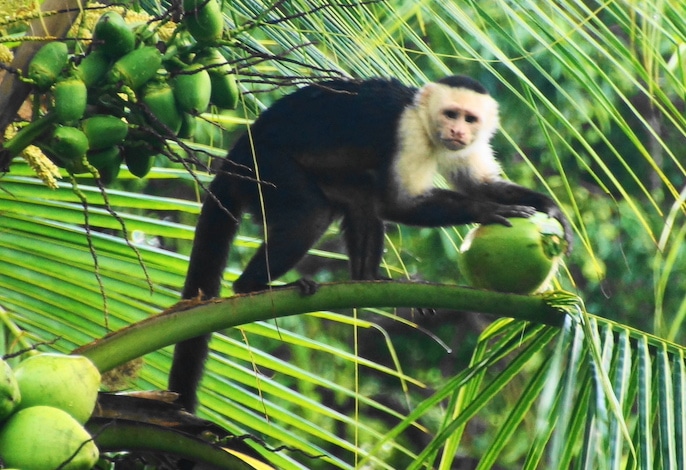
Keep your knapsack close around this fellow. The capuchin monkey is an unrepentant pickpocket, who won’t hesitate to complain vociferously if you haven’t any goodies to offer. Photo by Rob Stoeltje, Wikicommons
By Liz Campbell
A clan of howler monkeys troops along a strand of electrical lines high beside the road indifferent to the humans far below. Howlers are just one of four species of monkey living in Costa Rica. Two days earlier, as we zip lined through the forest canopy, a group of white-faced capuchin monkeys greeted our performance with a chorus of critical screeches. We were transfixed watching their antics just a few meters away but kept our cameras close. Stories abound about these pint-sized pickpockets of the Central American jungle. Given a few seconds, capuchins will even open backpacks.
There are few places left in the world where one might see sights like this, but the driver’s response to our enthusiasm is simply, Pura vida.
‘Pure Life’ may seem a strange response, but in Costa Rica, the phrase replaces ‘thank you’, ‘hello’, ‘goodbye’, ‘okay’, and in this case, ‘right on!’ Pura vida perfectly sums up the ethos of a country whose focus on making life more ‘pure’ has become the stuff of legend.
It wasn’t always so. In the early and mid-20th century, Costa Rica was a Central American banana republic. Like its neighbors it was beholden to the United Fruit Company, which controlled vast territories and transportation networks in Central America. They cleared out forests, filled in swamps and installed sewage, drainage and water systems to create vast banana and pineapple plantations. In the process, existing ecosystems were destroyed and biodiversity diminished.

Colourful markets abound with souvenirs, and everywhere the national slogan proclaims ‘Pura Vida’.
Others joined in the deforestation of the country. Logging companies cut down whole forests looking for select species like mahogany and cedar. Other timbered areas were transformed into pasture or clear-cut to create farms. By the mid-1900s, the rainforests of Costa Rica were rapidly disappearing.
Turning plantations into forests
In 1969 things began to change. Costa Rica passed its first forestry law regulating logging permits and creating a Forestry Department. Despite good intentions, it would be another decade before change began in earnest. By1981, the tree canopy that once covered 99.8% of Costa Rica had been reduced to just 31%.
Significant support came in 1984 with a loan for natural resource conservation from the United States Agency for International Development. In 1989, Costa Rica’s foreign debt was renegotiated so that the money could be reinvested into environmental conservation. Because the country eliminated its armed forces in 1948, it now had the funds it needed to start reversing the destruction.
Since 1987, Costa Rica has doubled the size of its forests. The extraordinary thing, says naturalist, Sir David Attenborough, is that the forests have regenerated. “Nature is very resilient,” he explained in an interview about the filming of his most recent documentary, Life in Color. “I was in Costa Rica 25 years ago and this was a field with cows. Now, here I am hacking through jungle…. This country made a commitment to ecotourism that wasn’t just empty words. The nature reserves are a joy to visit.”
Green is the color of money
Tributes from such well-respected sources have boosted the country’s ecotourism effort. Since 1995, businesses in the tourism sector must earn a Certification for Sustainable Tourism to ensure they follow a sustainable model of natural, cultural and communal reserve management. As a result, tourism receipts over the past 25 years have risen from $763 million to $4.1 billion. Costa Rica today attracts about 3.39 million visitors annually, nearly a million more than any other Central American nation, including Panama whose canal is an enormous draw. Indeed, tourism accounts for more than 9% of Costa Rica’s total employment.
Costa Rica is a success story in terms of development. It is the only tropical country in the world to have reversed deforestation and, according to the World Bank, is “a global leader for its environmental policies and accomplishments, which have helped the country to build its Green Trademark.”
All this has made Costa Rica the darling of environmentalists across the developed world. More significantly, this tiny Central American country is proving that protecting and nurturing natural landscape can be a route to prosperity.
Costa Rica starts with a great many advantages, which it is now at pains to protect. While it accounts for only 0.03% of the earth’s surface, Costa Rica contains nearly 6% of the world’s biodiversity. It has more species of butterflies than the entire continent of Africa. This tiny land mass encompasses 12 distinct microclimates, so Costa Rica has it all – beaches on the Pacific and Caribbean coasts, tectonic mountains, volcanoes, cloud forests, rain forests and 14 major river systems.
Offering an exotic landscape appeals to tourists, who annually contribute 8.3% of the country’s GDP. Making sustainability the focus attracts a whole new breed of visitor looking for conscience-appeasing, low-impact eco-adventure in a country that values the environment.
Don’t forget San Jose
The gateway to Costa Rica is its capital, San Jose. Sadly, most visitors on arrival promptly leave the airport for the white sand beaches along the coast or to explore the mountains and forests of the interior. Sitting in a vast plain, San Jose is encircled by rolling hills and imposing volcanoes. Its Spanish colonial roots are reflected in the city’s spacious plazas and handsome buildings. And San Jose boasts several world-class museums including one dedicated to gold and another housing the largest collection of pre-Columbian jade in the world.

You’re more apt to find – and enjoy – a Churchill in San Jose than in London
Dining in San Jose is on a par with the continent’s leading capital cities. The chef at Grano de Oro, one of the country’s finest inns, blends Costa Rican and French cuisines in dishes like pork tenderloin with tamarind sauce served with yucca croquettes and mango chutney. Don’t dismiss Costa Rican cuisine as vaguely Mexican. Try authentic dishes like Gallo Pinto or Casado. Like most Central American cuisines, they start with beans and rice, but there the similarity ends.
By the way, don’t confuse a Soda as a soda fountain. Soda is Costa Rican speak for a restaurant. But if you are looking for a frosty beverage, treat yourself to a distinctly Costa Rica treat – the Churchill – an amazing blend of shaved ice, flavoured syrup, powdered milk and condensed milk. Definitely weird but wonderfully delicious, it was named for its creator who apparently looked liked the famous British statesman.
One man’s vision
Costa Rica boasts dozens of eco-lodges and environmentally conscious hotels. This vision for sustainable tourism started in Guanacaste Province before the Millennium with the planting of trees on deforested land by Pablo Gordienko. He wanted to create a completely self-sustaining hotel so he set to work using different building techniques.
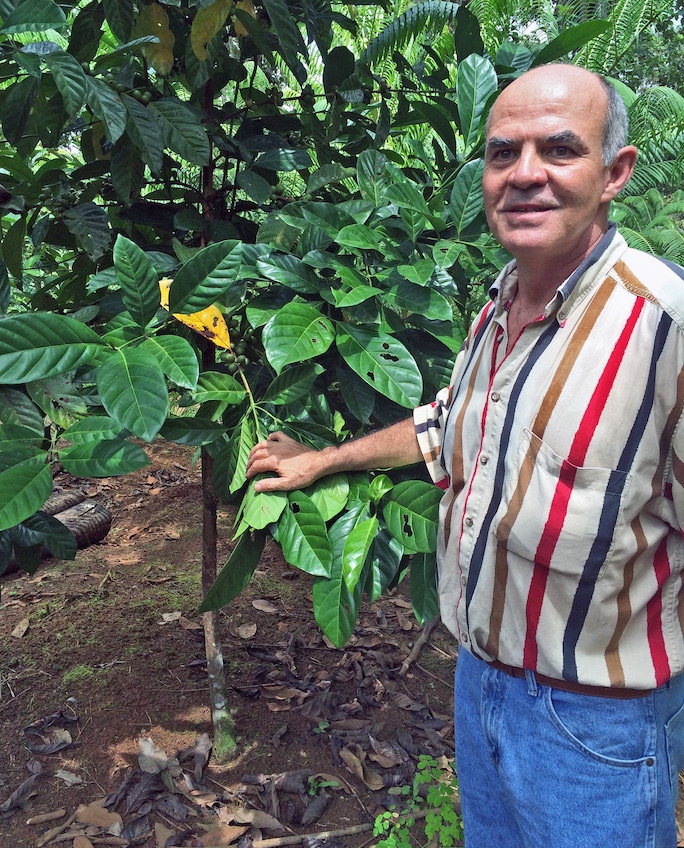
Pablo Gordienko grows mutually beneficial plants together. The coffee and cocoa plants are shaded by these Inga trees, a nitrogen-fixing legume. The white pulp of the Inga bean is sweet and tastes like ice cream.
Gordienko’s Macaw Lodge today serves as an example of what sustainable development can accomplish. The main building is constructed from reclaimed plantation wood harvested from storm damaged trees. Inside the furnishings and furniture are hand-built, mostly from teak which Gordienko planted. The floors are quarried stone, polished to a marble gloss. Enormous windows maximize daylight, and homemade, low wattage LED fixtures light the night. Low wattage is key since the lodge generates and stores its own electricity from enormous solar panels.
Even the ceiling fans are specially designed to use only six watts of power. Power is 12 volt DC so guests can only charge mobile phones at one of two special power stations; there are no outlets for hair dryers or shavers.
Water comes from natural springs and goes through three sediment filters, a charcoal filter, then finally through UV light. The sun heats hot water so showers are low flow. A closed system sends sewage to bio-digester. Gray water goes to a water bed that is reused for irrigation and toilets.
But it’s the approach to dining that really sets this spot apart. Gordienko’s enthusiasm for providing healthy and sustainable menus has driven him to grow foods most operators purchase – cocoa, coffee, hibiscus for jelly and syrup, rice, and nuts.
Macaw’s coffee and cocoa plants are shaded by Inga trees, a nitrogen-fixing legume. The white pulp of the Inga bean is sweet and tastes like ice cream. “The point is that in landscaping, we build relationships,” explains Gordienko. “We’re developing functional gardens that are attractive but good for animals. For example, our cattails attract hummingbirds.”
The gardens produce nearly everything served on the hotel’s menu. In addition to papaya, mango and plantains, there are four varieties of spinach, an heirloom variety of rice, vegetables for every occasion plus culinary and medicinal herbs.
In an old shipping container transformed into a mini factory, hotel employees make chocolate bars. In fact, Macau Kakau chocolate from their own cocoa pods won bronze at the International Chocolate Awards in 2019. Adds Gordienko with enormous pride, “We are the first company in Costa Rica to export chocolate to Switzerland!”
All this has made Macau Lodge a favourite retreat for yoga enthusiasts and serious environmentalists.
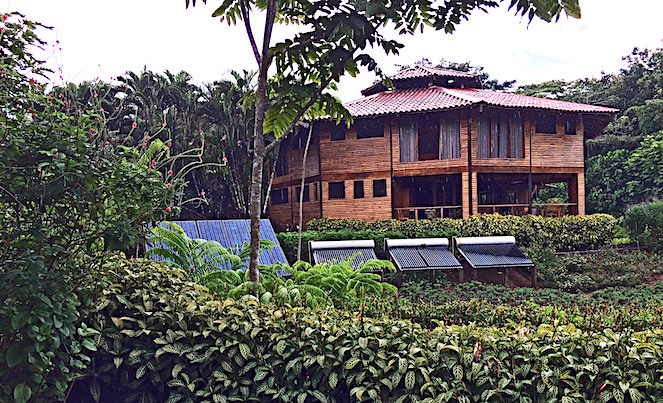
From the outset, Macau Lodge has aimed to be self-sustaining. In addition, nearly everything on the menu is grown on the property.
Voluntourism – Fun vacations enhance young travelers’ resumés
Costa Ricans enthusiasm for protecting its eco-heritage is matched by thousands of travellers who visit the country every year for more than just a holiday. These visitors come to volunteer and they provide an enthusiastic labor force.
At Ostional on the Pacific Coast, Shami Sindayigaya, a Canadian student on a gap year, is here to help with the turtle rescue program. “I just wanted a change,” she smiles. “And to see if I really wanted to do eco-management.”
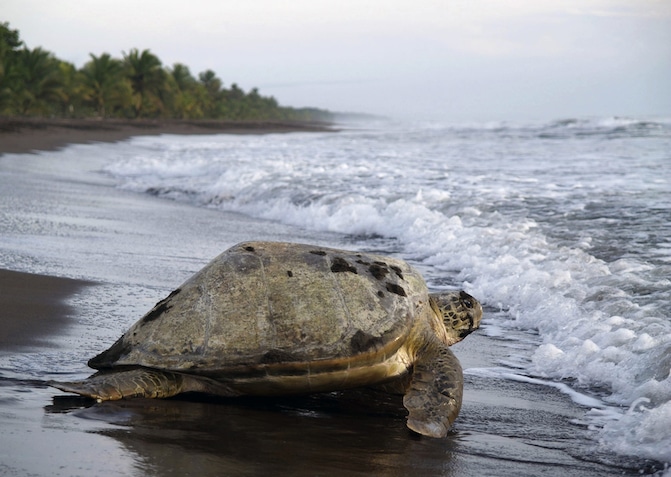
Enormous leatherback turtles struggle ashore to lay their eggs on the beaches of Ostional.
Just two days earlier, she watched as thousands of turtles came ashore to lay their eggs on this eight mile stretch of beach. It’s an event that is repeated several times throughout the laying season. And because turtle eggs are a delicacy, the volunteers are here to protect them as well as track the numbers.
The last arribada, as these arrivals are called, brought an estimated 278,000 turtles over six days. Each female crawls ashore, then uses her enormous flipper to create a bed in the sand. Here she lays up to 100 eggs and covers them with sand. “It’s an awesome sight!” says Shami.
Anne Stahl, from Middlebury, VT, is new to the group. “The first time I saw a leatherback turtle, it looked like a monster,” she says, the awe still evident. “It’s been an incredible experience working here – cleaning beaches, collecting data, making sure everything is okay for the arribada.”
There are15 volunteers currently at Ostional, aged 18 to 65. Some stay for two weeks, others for six months. Most live with local families and gather for meals and for relaxation. Connor Koblansky, from Tuscon Arizona, is taking a year off after high school to improve his Spanish and ponder an eventual career path. “This is a life-changing experience,” he confides. “I’m going to major in Biology and get involved when I return to the U.S.”
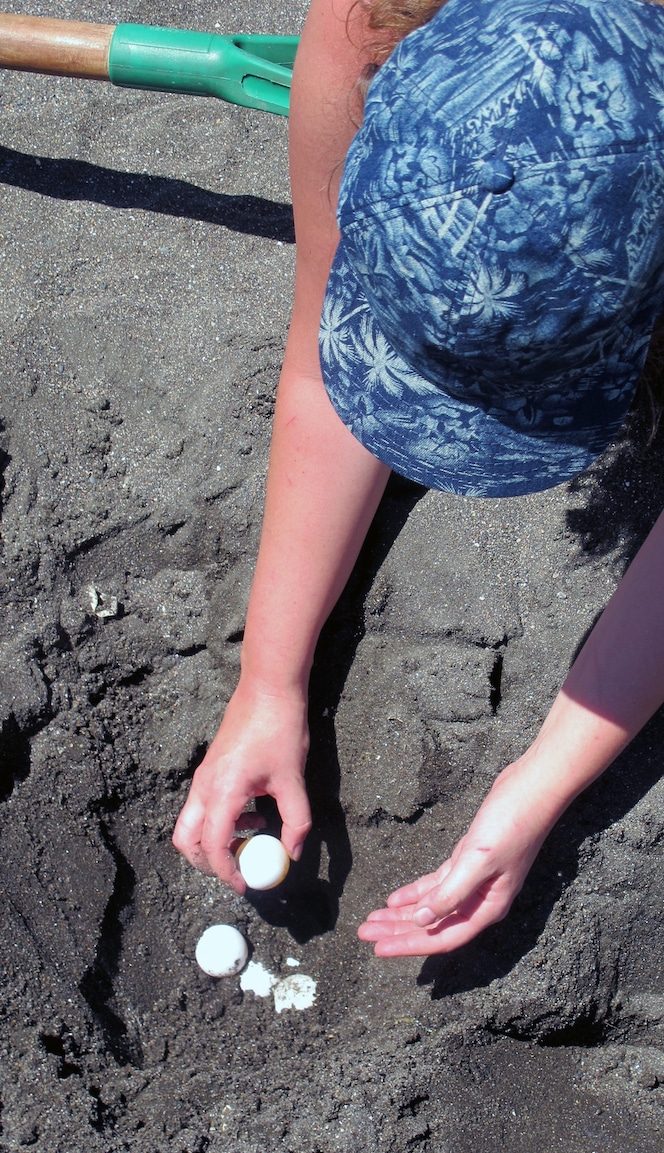
Volunteers collect turtle eggs and move to safety, away from predators – both animal and human.
Bats, stalactites, capuchins and kinkajous
At nearby Barra Honda National Park, Heloise, a volunteer from France, is working with local naturalists to track bat populations in one of the 42 caves. Studded by stalactites and stalagmites the caves are the limestone remains of ancient coral reefs pushed upward by tectonic faults 60 million years ago. Only 19 have been explored.
Until the caverns were discovered in the late sixties, people believed Cerro Barra Honda was a volcano because of its fumes and the roaring sounds made by the bats as they departed the caverns en masse.
In truth, the hiking trails around the caverns lead to one of the rarest habitats on earth: a tropical dry forest. Some of the trees flower only after they’ve dropped all their leaves. The protection provided by Barra Honda has permitted many animal species in the surrounding forest to recover from the brink of extinction. Now you might see capuchins, howler monkeys, deer, raccoons, peccaries, kinkajous, agoutis, and anteaters.
Volunteers are needed to help maintain the forest and assist local naturalists collect data. Those who pursue the work-study challenge on their vacation are offered rooms in the park as well as accommodation with locals. On their weekend off, volunteers visit local towns and beaches or enjoy attractions like zip-lining or boat tours.
A favorite activity is visiting local schools to work with children, says Andrea Prendas, volunteer program coordinator at Barra Honda. “The volunteers fall in love with this place,” she says. “It’s different than being in the city. You might be woken by a howler monkey. You can hear the birds, the animals, the rain on the trees.
“We’ve had volunteers who have never touched a shovel, but here they do,” adds Prendas. “Many contact us and come back several times. And they send us letters asking about the kids at the school.”
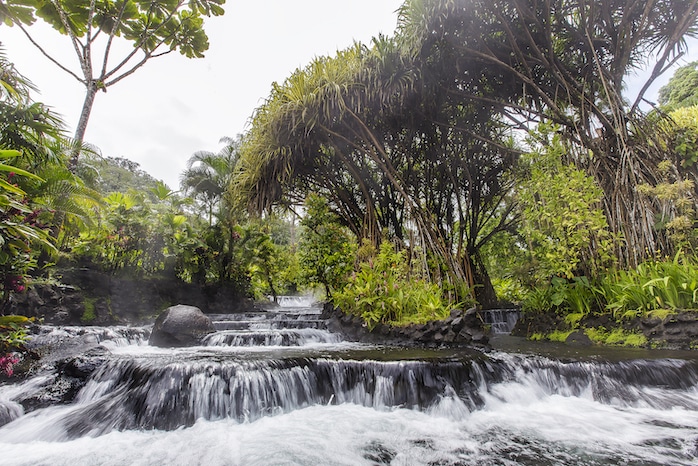
Tabacón Hot Springs are mineral-laden thermal springs popular for treating a variety of aches and pains. Their location in a tropical rainforest at the base of the Arenal Volcano makes these even more spectacular.
Is sustainable tourism the future?
The UN General Assembly in 1993 created the first International Day for Biological Diversity. Today it is known as World Biodiversity Day and celebrated every May 22. Taleb Rifai, Secretary General of the United Nations World Tourism Organization, spent most of his tenure promoting sustainable eco tourism as a tool for fighting poverty and promoting sustainable development. Notes Elizabeth Mrema, Acting Executive Secretary of the Convention on Biodiversity: “Despite all our technological advances we are completely dependent on healthy and vibrant ecosystems for our water, food, medicines, clothes, fuel, shelter and energy.”
As that message spreads, and concerns about global warming grow, travellers are looking for real encounters with the people and landscape they visit. They want to see the world but hope to feel they aren’t harming it in the process. “I think people want an authentic experience,” agrees Pablo Gordienko. “They want to feel good about what they are doing and what they are eating.”
The example of Costa Rica, where men like Gordienko are building an ever more profitable tourism sector, has not gone unnoticed. Eco tourism and what has become known as voluntourism have caught the attention of more than just travellers looking for a feel-good holiday.
Will the example of a tiny and financially vulnerable country like Costa Rica encourage larger nations to take similar measures? If anything will convince them, it is Costa Rica’s ability to sustainably turn green to gold.![]()
Liz Campbell has been a freelance travel and food writer for more than 20 years with stories published in The Globe & Mail, Zoomer and Foodservice & Hospitality magazine. Her recent stories for EWNS include an exploration of fairies in Ireland, the bizarre Yukon outpost of Dawson, the tiny country of Malta and surprisingly lively Buffalo, NY.

